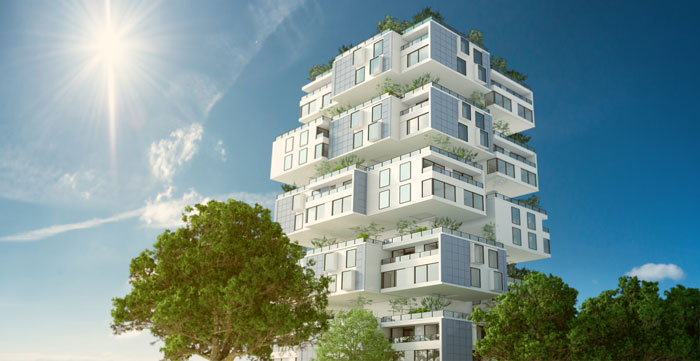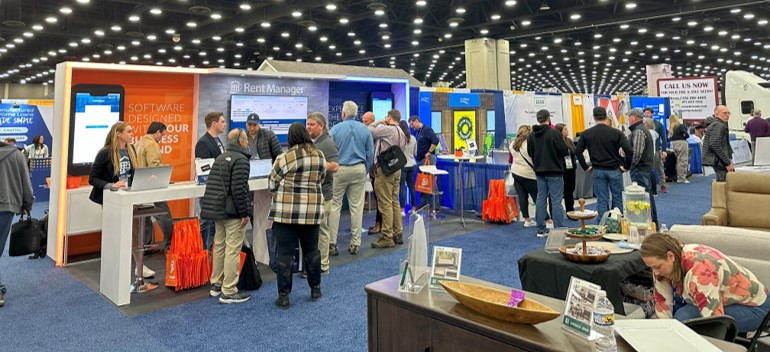What will housing and apartments look like in the future? A condominium on Mars? Maybe, but we’re not going THAT far for the purposes of this blog. One thing is certain though, the housing industry is always evolving. As technologies, lifestyles, and society advances and changes, so does the way we develop our communities. To meet housing demands, the United States will have to build 4.6 million apartments across all price points by 2030.
Things are already beginning to shift in the way we live, which will shape the future of rental housing and the way property managers interact with their residents and communities. Currently, the 55+ generation is increasingly moving from homes into luxury multifamily properties to be closer to their children and have the flexibility to travel more. This means developers and property managers will be tasked with appealing to multiple generations with multiple lifestyles more than ever before.
Trend #1: Smart Apartments
In the past, must-have amenities included a pool or balcony, but that’s no longer the case. As smart-home technology continues to rise—and property owners and managers continue to see the cost savings and benefits it provides—it’s adoption in rental properties will increase, too. Smart buildings result in increased efficiency. According to Forbes, “Integrating smart devices and high-tech building management systems is not only essential to attracting and retaining renters of all ages, but the cost savings can be a win-win for residents and property managers alike.”
Residential property managers across the country are already realizing dramatic savings and operational improvements from smart-home property automation features. Things like smart locks, enhanced HVAC systems and smart thermostats, and in-home smart security systems are addressing the needs of renters. In the future, expect this technology to go beyond individual units, enabling residents to connect with the property in more ways.
Trend #2: The Rise of Remote Work
Jobs are changing. As office environments continue to evolve, many companies are finding improved engagement and productivity by empowering their workforce to operate remotely. This means your future residents won’t necessarily be strapped to their desk in a typical 9-to-5 job. It also means that their living environments will need to accommodate their workplace requirements. According to a 2017 Gallup Poll, 43% of employed Americans said they spent at least “some time” working remotely. Not only are more employees working from home, they are also doing it more frequently.
This trend will drive significant changes to apartment layouts and the amenities that will become must-haves. Property owners in the multifamily space will also want to consider placing a higher emphasis on shared, community workspaces and co-working areas. As more prospective residents are spending more time at their “home office,” properties that cater to this lifestyle will have a competitive advantage.
Trend #3: Shared Spaces
As the arms race for amenities continues to heat up, it’s no longer about which property offers the biggest clubhouse or nicest pool. The National Multifamily Housing Council’s Disruption report mentions that “traditional retail looks to be heading toward a serious upheaval, leading apartment communities to consider how new models can best be incorporated on site.” The rise in online shopping has already forced rental properties to adapt to accommodate the increase in packages being shipped to residents. Retail trends will continue to impact the way rental properties operate.
Multifamily communities of the future will turn their focus beyond their own residents and open their shared spaces to the community at large. Since it’s becoming more and more common for cities to require mixed-use components in new developments, look for apartments to utilize their spaces to benefit their surrounding areas—incorporating businesses like coffee shops, retail stores, restaurants, and entertainment.

Trend #4: A New Era of Transportation
Consumers have become more and more focused on environmentally friendly products, and the transportation industry is no exception. The number of new registrations for electric vehicles doubled in the U.S. in 2018 versus 2017. In 2020, the number of electric vehicles (EVs) sold in the U.S. is expected to surpass 350,000. With sales increasing 81% year over year, electric vehicles certainly aren’t a fad.
On top of EVs, ride-sharing giants like Lyft and Uber and bike sharing services are fueling a rise in Transportation as a Service. For developers and property owners, these changes mean rethinking parking accommodations at their properties. Rather than planning standard parking garages, things like EV charging stations and creating other transportation features to accommodate for changing vehicle technologies, will be critical.
Trend #5: Going Green
Now more than ever before, people aware of their environmental footprint and the effects their habits have on the Earth. As such, consumers are looking for sustainable features within their home. Energy-efficient appliances and windows already top the list of most-wanted features in a new home, and greatly influence the purchase decision. “Real estate has been proactive on sustainability issues for many years,” reads the Urban Land Institute’s annual Emerging Trends report. “As a matter of self-interest as well as social responsibility, the industry is moving ahead to advance its sustainability performance regardless of the direction of national policy.” In the future, these features will become a necessity for buyers and renters alike.
Sustainable features and smart appliances not only save residents money on utility bills, they also work to promote a healthy living environment. Multifamily developers in the luxury space have begun going one step further, bringing nature to their properties. In an effort to bridge the gap between urban living, developers are beginning to implement large green space or rooftop parks for their residents. No longer will residents have to choose between city living and having green space.
As technologies continue to shape everything we do—the way we shop, the way we eat, the way we get where we need to go—the way developers and rental housing professionals appeal to residents will also have to evolve. We live in the age of disruption, and as every industry undergoes seismic shifts in order to connect with their target audience, these are a few of the trends multifamily housing professionals will need to keep in mind.
 Register for RMUC.25
Register for RMUC.25





